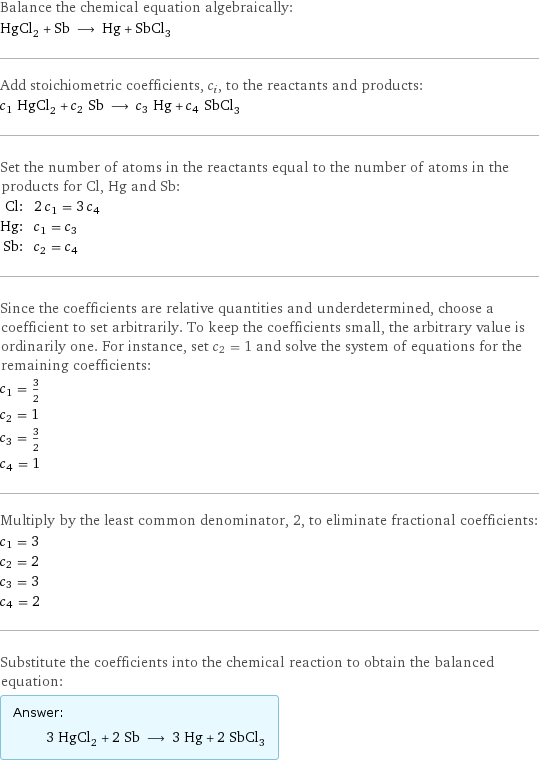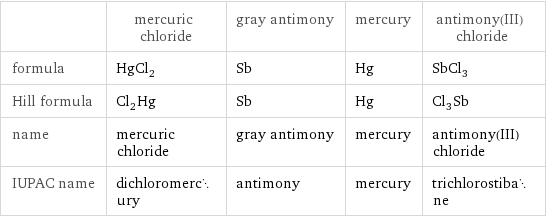Input interpretation

HgCl_2 mercuric chloride + Sb gray antimony ⟶ Hg mercury + SbCl_3 antimony(III) chloride
Balanced equation

Balance the chemical equation algebraically: HgCl_2 + Sb ⟶ Hg + SbCl_3 Add stoichiometric coefficients, c_i, to the reactants and products: c_1 HgCl_2 + c_2 Sb ⟶ c_3 Hg + c_4 SbCl_3 Set the number of atoms in the reactants equal to the number of atoms in the products for Cl, Hg and Sb: Cl: | 2 c_1 = 3 c_4 Hg: | c_1 = c_3 Sb: | c_2 = c_4 Since the coefficients are relative quantities and underdetermined, choose a coefficient to set arbitrarily. To keep the coefficients small, the arbitrary value is ordinarily one. For instance, set c_2 = 1 and solve the system of equations for the remaining coefficients: c_1 = 3/2 c_2 = 1 c_3 = 3/2 c_4 = 1 Multiply by the least common denominator, 2, to eliminate fractional coefficients: c_1 = 3 c_2 = 2 c_3 = 3 c_4 = 2 Substitute the coefficients into the chemical reaction to obtain the balanced equation: Answer: | | 3 HgCl_2 + 2 Sb ⟶ 3 Hg + 2 SbCl_3
Structures

+ ⟶ +
Names

mercuric chloride + gray antimony ⟶ mercury + antimony(III) chloride
Reaction thermodynamics
Enthalpy

| mercuric chloride | gray antimony | mercury | antimony(III) chloride molecular enthalpy | -224.3 kJ/mol | 0 kJ/mol | 0 kJ/mol | -382.2 kJ/mol total enthalpy | -672.9 kJ/mol | 0 kJ/mol | 0 kJ/mol | -764.4 kJ/mol | H_initial = -672.9 kJ/mol | | H_final = -764.4 kJ/mol | ΔH_rxn^0 | -764.4 kJ/mol - -672.9 kJ/mol = -91.5 kJ/mol (exothermic) | | |
Equilibrium constant
![Construct the equilibrium constant, K, expression for: HgCl_2 + Sb ⟶ Hg + SbCl_3 Plan: • Balance the chemical equation. • Determine the stoichiometric numbers. • Assemble the activity expression for each chemical species. • Use the activity expressions to build the equilibrium constant expression. Write the balanced chemical equation: 3 HgCl_2 + 2 Sb ⟶ 3 Hg + 2 SbCl_3 Assign stoichiometric numbers, ν_i, using the stoichiometric coefficients, c_i, from the balanced chemical equation in the following manner: ν_i = -c_i for reactants and ν_i = c_i for products: chemical species | c_i | ν_i HgCl_2 | 3 | -3 Sb | 2 | -2 Hg | 3 | 3 SbCl_3 | 2 | 2 Assemble the activity expressions accounting for the state of matter and ν_i: chemical species | c_i | ν_i | activity expression HgCl_2 | 3 | -3 | ([HgCl2])^(-3) Sb | 2 | -2 | ([Sb])^(-2) Hg | 3 | 3 | ([Hg])^3 SbCl_3 | 2 | 2 | ([SbCl3])^2 The equilibrium constant symbol in the concentration basis is: K_c Mulitply the activity expressions to arrive at the K_c expression: Answer: | | K_c = ([HgCl2])^(-3) ([Sb])^(-2) ([Hg])^3 ([SbCl3])^2 = (([Hg])^3 ([SbCl3])^2)/(([HgCl2])^3 ([Sb])^2)](../image_source/35af20ff8a973bf4324e7b490a256ddd.png)
Construct the equilibrium constant, K, expression for: HgCl_2 + Sb ⟶ Hg + SbCl_3 Plan: • Balance the chemical equation. • Determine the stoichiometric numbers. • Assemble the activity expression for each chemical species. • Use the activity expressions to build the equilibrium constant expression. Write the balanced chemical equation: 3 HgCl_2 + 2 Sb ⟶ 3 Hg + 2 SbCl_3 Assign stoichiometric numbers, ν_i, using the stoichiometric coefficients, c_i, from the balanced chemical equation in the following manner: ν_i = -c_i for reactants and ν_i = c_i for products: chemical species | c_i | ν_i HgCl_2 | 3 | -3 Sb | 2 | -2 Hg | 3 | 3 SbCl_3 | 2 | 2 Assemble the activity expressions accounting for the state of matter and ν_i: chemical species | c_i | ν_i | activity expression HgCl_2 | 3 | -3 | ([HgCl2])^(-3) Sb | 2 | -2 | ([Sb])^(-2) Hg | 3 | 3 | ([Hg])^3 SbCl_3 | 2 | 2 | ([SbCl3])^2 The equilibrium constant symbol in the concentration basis is: K_c Mulitply the activity expressions to arrive at the K_c expression: Answer: | | K_c = ([HgCl2])^(-3) ([Sb])^(-2) ([Hg])^3 ([SbCl3])^2 = (([Hg])^3 ([SbCl3])^2)/(([HgCl2])^3 ([Sb])^2)
Rate of reaction
![Construct the rate of reaction expression for: HgCl_2 + Sb ⟶ Hg + SbCl_3 Plan: • Balance the chemical equation. • Determine the stoichiometric numbers. • Assemble the rate term for each chemical species. • Write the rate of reaction expression. Write the balanced chemical equation: 3 HgCl_2 + 2 Sb ⟶ 3 Hg + 2 SbCl_3 Assign stoichiometric numbers, ν_i, using the stoichiometric coefficients, c_i, from the balanced chemical equation in the following manner: ν_i = -c_i for reactants and ν_i = c_i for products: chemical species | c_i | ν_i HgCl_2 | 3 | -3 Sb | 2 | -2 Hg | 3 | 3 SbCl_3 | 2 | 2 The rate term for each chemical species, B_i, is 1/ν_i(Δ[B_i])/(Δt) where [B_i] is the amount concentration and t is time: chemical species | c_i | ν_i | rate term HgCl_2 | 3 | -3 | -1/3 (Δ[HgCl2])/(Δt) Sb | 2 | -2 | -1/2 (Δ[Sb])/(Δt) Hg | 3 | 3 | 1/3 (Δ[Hg])/(Δt) SbCl_3 | 2 | 2 | 1/2 (Δ[SbCl3])/(Δt) (for infinitesimal rate of change, replace Δ with d) Set the rate terms equal to each other to arrive at the rate expression: Answer: | | rate = -1/3 (Δ[HgCl2])/(Δt) = -1/2 (Δ[Sb])/(Δt) = 1/3 (Δ[Hg])/(Δt) = 1/2 (Δ[SbCl3])/(Δt) (assuming constant volume and no accumulation of intermediates or side products)](../image_source/9cdedc2a6158c046217fc081c3b88e4a.png)
Construct the rate of reaction expression for: HgCl_2 + Sb ⟶ Hg + SbCl_3 Plan: • Balance the chemical equation. • Determine the stoichiometric numbers. • Assemble the rate term for each chemical species. • Write the rate of reaction expression. Write the balanced chemical equation: 3 HgCl_2 + 2 Sb ⟶ 3 Hg + 2 SbCl_3 Assign stoichiometric numbers, ν_i, using the stoichiometric coefficients, c_i, from the balanced chemical equation in the following manner: ν_i = -c_i for reactants and ν_i = c_i for products: chemical species | c_i | ν_i HgCl_2 | 3 | -3 Sb | 2 | -2 Hg | 3 | 3 SbCl_3 | 2 | 2 The rate term for each chemical species, B_i, is 1/ν_i(Δ[B_i])/(Δt) where [B_i] is the amount concentration and t is time: chemical species | c_i | ν_i | rate term HgCl_2 | 3 | -3 | -1/3 (Δ[HgCl2])/(Δt) Sb | 2 | -2 | -1/2 (Δ[Sb])/(Δt) Hg | 3 | 3 | 1/3 (Δ[Hg])/(Δt) SbCl_3 | 2 | 2 | 1/2 (Δ[SbCl3])/(Δt) (for infinitesimal rate of change, replace Δ with d) Set the rate terms equal to each other to arrive at the rate expression: Answer: | | rate = -1/3 (Δ[HgCl2])/(Δt) = -1/2 (Δ[Sb])/(Δt) = 1/3 (Δ[Hg])/(Δt) = 1/2 (Δ[SbCl3])/(Δt) (assuming constant volume and no accumulation of intermediates or side products)
Chemical names and formulas

| mercuric chloride | gray antimony | mercury | antimony(III) chloride formula | HgCl_2 | Sb | Hg | SbCl_3 Hill formula | Cl_2Hg | Sb | Hg | Cl_3Sb name | mercuric chloride | gray antimony | mercury | antimony(III) chloride IUPAC name | dichloromercury | antimony | mercury | trichlorostibane